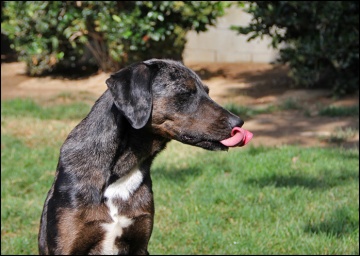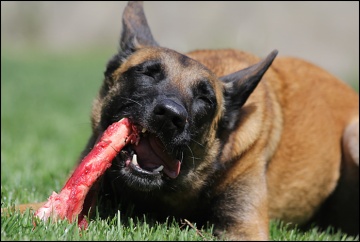A video recently has made the rounds, showing dog trainer celebrity Cesar Millan working with a food guarding Labrador named Holly. We do not know much about Holly’s history, but the it is understood at the beginning of the video, that she has major food aggression issues. In this short film by National Geographic we see him moving into the dog’s space as she is eating out of her food bowl. As he is pushing her away, he explains her body language and just as he reaches to pet her, she turns and bites his hand.
Why Millan was not able to read the dog’s clear body language and endanger him as well as Holly, is one issue and not one we will discuss here. I would like to focus on a resource guarding dog’s behavior and what might be a better solution to tackle the problem.
First we need to understand resource guarding, how it looks like and when it can happen. There are many ways and levels resource guarding shows in a dog. It can be directed towards people, dogs or other animals or even things in the environment including changes in their immediate surroundings. Some dogs guard food, some ‘protect’ toys, other dogs or pack members including people, even places like their crates, beds or couches. A dog might guard a specific toy but be completely fine with other toys or show guarding behavior only towards certain people. It is important that we understand the variety of resource guarding. It is equally important to understand, that not always does it mean you will encounter a teeth baring, snarling Cujo cowering over his bone. More often than not, it is a subtle protective move with the head over the item, stiffening the body and carefully eyeing the intruder. Many dogs won’t go beyond that, but make no mistake – this is just as much a guarding behavior as baring teeth, ready to attack. It is a natural behavior, but it can’t be accepted in our society.
There are a myriad of reasons why a dog starts to display signs of resource guarding. Some breeds are more prone to it than others, some dogs have had to fight for their resources growing up, some do not (yet) trust their owners and some just take advantage of their owners’ weaknesses. The last one is popular with people who attribute many dog behaviors to dominance and they will tell you, not to allow your dog to show this behavior and to take charge. Some will make you roll your dog on its back or have you go into some sort of kung fu stance over the item of the dispute and staring down the dog, much like Millan does it in the video. The outcome is rarely a good one. At the very least, you will destroy whatever trust is between you and your dog – and in the worst case, you have created a liability, a dog who has lost any bite inhibition and will start latching onto anything that comes close to it.
While it may help with working on the issue, we may not always have the luxury of knowing our dog’s history and thus the reason for its reaction. So what to do? First and foremost, do not wait until the situation escalates. If you see your dog cowering over a toy, getting stiff when you approach while your dog’s eating or hear your dog growling lowly when you get near its favorite sleeping location, it’s time to work on it.

Looking away and licking the nose – this can be the sign of a stressed dog wanting to calm down the situation
Don’t escalate the moment
If your dog is displaying the above mentioned signs, it is not the right time to take away the item or chase your dog off the couch. It doesn’t mean that you have to let it slide, just re-schedule the training to a time when your dog isn’t about to chomp down on you. Believe it or not, but this isn’t a situation that your dog enjoys. Most likely your dog displays signs of stress between the growling and being stiff. Licking its nose, trying to look away, pretending to sniff the air or even backing off a bit all means, that really, neither one of you want to be in this situation.
Getting your dog away from the item
If your dog guards the couch, try to get it down by offering a yummy treat (often just going into the kitchen and opening the fridge door may be enough). If that doesn’t work, calmly put a leash on your dog and lead him off. It is important, that you keep calm and are not afraid. Once your dog is off the couch, don’t let it get up again. The same works with a food or toy item as well. If you don’t want to get too close to your dog, calmly throw the treats as you walk closer. Don’t walk straight up to your dog, turn your body side ways and do not stare at your dog. It is important that the treats are better than whatever your dog has in its possession. Hot dogs or cheese work usually very well. Don’t corner your dog. Make sure, he can walk away.
Training the resource guarding dog
The most important thing you will need, to work on this issue with your dog, is trust. If your dog fears you or thinks, that you will take away its toy every time you get close, you won’t have much success.

Ideal situation: eating a bone and be completely comfortable and relaxed with someone standing close
So instead of always reaching for the toy when your dog is close to you, just pet your dog and let it have it for a while, even when you play fetch. Work on the threshold, how close you can get while your dog is eating without stressing your dog or making it feel uncomfortable. It may take a couple of days to weeks, depending on the level of the guarding. If you have to, feed your dog from your hand instead of letting it eat from a bowl, at least for a while. When your dog is eating from a bowl, walk by or get closer and either throw a piece of hot dog or, if you can get that close, feed that treat from your hand, so your dog gets used to you being around its food or toy and knows, something good is going to happen. Swap a good toy with a better one or a treat when your dog is playing.Make sure, the situation is calm and relaxed. Take your time. This builds trust and lets you work on the distance, where you can get close to your dog without your dog feeling the need to guard its possession.
Having a place set up for your dog
Your dog needs a safe place – for some dogs it is the crate, some have a blanket or a dog bed, but dedicate a place, where no one bothers your dog. Let this be your dog’s haven where he can go, when he is stressed. Do not let visitors or children bother your dog when he is resting there.
Setting up a plan for the future
Don’t mistake the above training tips for showing weakness. You can’t fight fire with fire in this case. Yelling and poking at your dog in this stressful situation will make everything worse. This is about defusing, de-escalating and creating a more stable relationship where you can build on. Additionally to the above direct measurements about resource guarding, you will need to establish boundaries. This is where your leadership comes in. Work on your dog’s general obedience, be strong, consistent and fair. If you are uncertain or if your dog’s behavior already includes biting, consult with a trainer, who has experience with dogs like that. Be suspicious, if the first thing a trainer does, is slapping a training collar on your dog. Establish realistic goals – if your dog has shown resource guarding behavior for the last seven years, don’t expect it to change within three days. Document any behaviors in order to see the progress.
Resource guarding is an issue of trust, boundaries and patience. It is not about showing who’s stronger or more powerful.

